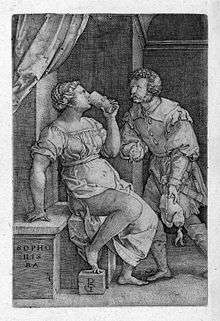The Wonder of Women
| The Wonder of Women, or The Tragedy of Sophonisba | |
|---|---|
 (16th-century copperplate print by Georg Pencz) | |
| Written by | John Marston |
| Characters | Sophonisba, Syphax, Massinissa, Scipio |
| Date premiered | c. 1606 |
| Place premiered | Blackfriar's Theatre |
| Original language | English |
| Genre | Jacobean |
| Setting | Carthage, c. 200 BCE |
The Wonder of Women or The Tragedy of Sophonisba is an early Jacobean stage play written by the satiric dramatist John Marston. It was first performed by the Children of the Revels, one of the troupes of boy actors popular at the time, in the Blackfriars Theatre.
The play was entered into the Stationers' Register on 17 March 1606, and published later that year by the bookseller John Windet. The title page of the first edition states that the play was acted at the Blackfriars, with no mention of the company's name — which indicates that the play must have been performed in late 1605 or early 1606, after the Queen's Revels Children has lost royal patronage as a result of the Eastward Hoe scandal.[1]
The play tells the story of the Carthaginian princess, Sophonisba, who is being lustfully pursued by an unwanted suitor, the lecherous and unscrupulous Syphax, despite her having recently married the noble warrior Massinissa. Meanwhile, Carthage is being attacked by the forces of the Roman general Scipio.
The plot is highly sensationalist and melodramatic, and the play features several scenes of high stylization, martial pomp, and ritual. In the address "To the General Reader," prefixed to the print edition of the play, Marston explains that he has written the play as a poetic statement, not a factually accurate history. The play's themes include the difficulty of acting honorably in a corrupt society, and the importance of maintaining personal integrity.
Notes
- ↑ Chambers, Vol. 3, p. 433.
References
- Caputi, Anthony. John Marston, Satirist. Ithaca, NY, Cornell University Press, 1961.
- Chambers, E. K. The Elizabethan Stage. 4 Volumes, Oxford, Clarendon Press, 1923.
- Finkelpearl, Philip J. John Marston of the Middle Temple. Cambridge, MA, Harvard University Press, 1969.